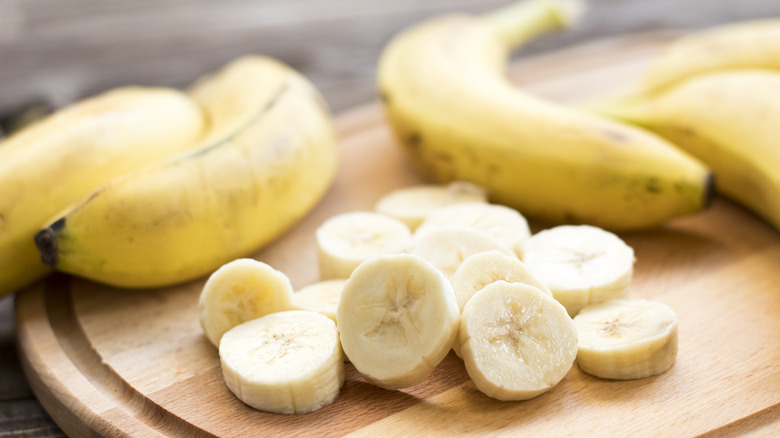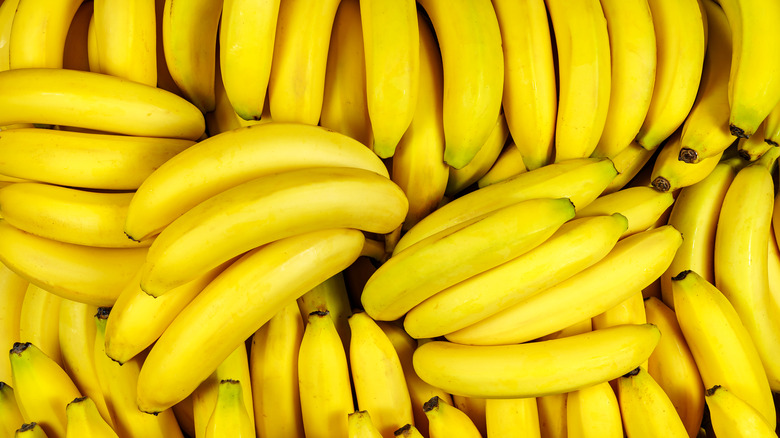The Reason Bananas Are Actually Considered Berries
A botanist walks into a (smoothie) bar and spots two items on the menu: a "mixed berry smoothie" and a "banana and blueberry smoothie." They find this distinction amusing because, in their mind, those items are the same. Although this might be figuratively difficult to stomach, bananas are indeed berries. In the botanical sense, berries are defined by their fleshy interiors, soft exteriors, and the fact that they stem from the ovary of a flower with a single ovule. Bananas meet these criteria perfectly, and, in this sense, share company and classification with kiwis, avocados, peppers, grapes, and blueberries.
Though, in a phenotypic sense, the foods that fall under the botanical berry umbrella look quite different from one another, and none of the examples in the list above are in any way interchangeable in terms of taste. Think of whipping up a batch of (usually) foolproof banana bread; if you substituted the mashed banana in this recipe for one of its botanical siblings like grapes, you'd have a much different outcome.
A berry in the eyes of the botanist
First things first, fruit is a broad umbrella in the plant world that includes berries, so bananas are both fruit and berry. To make sense of this confusing botanical classification, it's important to know how botanists define what a fruit is. Fruits include any seed-bearing structure that develops from the ovary (or ovaries) of a flowering plant. By this definition, fruits include foods we'd typically categorize as vegetables, like tomatoes, cucumbers, green beans, pumpkins, and nuts like acorns and almonds (as long as they're still in their shells).
The broad fruit category is divided into three smaller categories based on how the fruit grows. Simple fruits (like bananas, apples, grapes, oranges, peaches, and melons) develop from a single ovary. Aggregate fruits like strawberries develop from multiple ovaries. Multiple fruits like pineapples are made from a tight grouping of flowers.
Botanically, berries are a simple fruit with flesh and seeds. Interestingly, this category includes not just bananas, but citrus (in a special family called hesperidium), watermelons, cucumbers, and as you'd expect, cranberries and blueberries. You may notice that some familiar berries you'd typically store with your blueberries are missing from the botanical berry category, including strawberries, raspberries, and blackberries. That's because they develop from multiple ovaries, meaning they are aggregate fruits, not simple fruits.
Bananas and berries aren't interchangeable in the kitchen
In nutrition and cooking, the common classification of berries tends to be more relevant than their botanical one. When most people say berry, they mean small, sweet fruits you might pick from a bush. The word berry comes from the Old English word beire which referred to grapes. As the English language spread, people started calling other grape-like fruits berries. These names formed before botanists started classifying plants, hence why we call non-botanical berries ... berries. This commonly understood group includes foods with — you guessed it — berry in their name, like the strawberry, raspberry, blueberry, blackberry, cranberry, boysenberry, lingonberry, and huckleberry.
The foods we know as berries have more nutritional characteristics in common — like high levels of antioxidants, vitamin C, and fiber — than they do with botanical berries. For instance, although they are in different botanical categories, strawberries are more like blueberries than bananas in terms of their nutrient profile. Berries also share similar properties when used in recipes. Consider a pie — one made with bananas would require different steps and ingredients than one made with blueberries to yield an edible result. So while knowing that bananas are berries may impress your botanist friend and win you points at trivia (like knowing the fun fact that bananas are radioactive), don't feel like you have to classify them as such in your kitchen.


